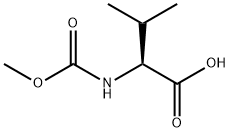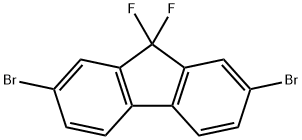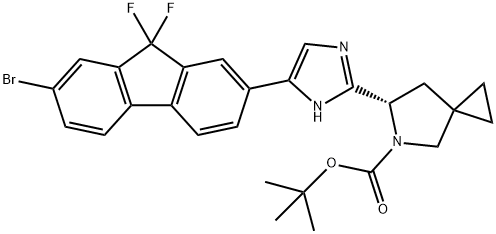(3S)-N-Boc-2-azabicyclo[2.2.1]heptane-3-carboxylic acid
- CAS NO.:291775-59-2
- Empirical Formula: C12H19NO4
- Molecular Weight: 241.28
- MDL number: MFCD11099876
- EINECS: 808-164-2
- SAFETY DATA SHEET (SDS)
- Update Date: 2025-01-27 09:38:02
![(3S)-N-Boc-2-azabicyclo[2.2.1]heptane-3-carboxylic acid Structural](https://img.chemicalbook.in/CAS/GIF/291775-59-2.gif)
What is (3S)-N-Boc-2-azabicyclo[2.2.1]heptane-3-carboxylic acid?
The Uses of (3S)-N-Boc-2-azabicyclo[2.2.1]heptane-3-carboxylic acid
(1R,3S,4S)-2-(tert-Butoxycarbonyl)-2-azabicyclo[2.2.1]heptane-3-carboxylic Acid is a building block in the synthesis of Ledipasvir, a potent, once-??daily oral NS5A inhibitor for the treatment of Hepatitis C Virus infection. It is also used to prepare potent direct inhibitors of factor Xa which carries significant promise for developing effective and safe anticoagulants.
What are the applications of Application
(1R,3S,4S)-N-Boc-2-azabicyclo[2.2.1]heptane-3-carboxylic acid is a bicyclic structure
Properties of (3S)-N-Boc-2-azabicyclo[2.2.1]heptane-3-carboxylic acid
| Melting point: | 147-152 °C |
| Boiling point: | 371.0±25.0 °C(Predicted) |
| Density | 1.232±0.06 g/cm3(Predicted) |
| storage temp. | Sealed in dry,Room Temperature |
| pka | 4.05±0.20(Predicted) |
| optical activity | [α]22/D -170±10°, c = 1 in chloroform |
Safety information for (3S)-N-Boc-2-azabicyclo[2.2.1]heptane-3-carboxylic acid
| Signal word | Danger |
| Pictogram(s) |
 Exclamation Mark Irritant GHS07  Health Hazard GHS08  Environment GHS09 |
| GHS Hazard Statements |
H315:Skin corrosion/irritation H319:Serious eye damage/eye irritation H335:Specific target organ toxicity, single exposure;Respiratory tract irritation H360:Reproductive toxicity H400:Hazardous to the aquatic environment, acute hazard |
| Precautionary Statement Codes |
P201:Obtain special instructions before use. P273:Avoid release to the environment. P302+P352:IF ON SKIN: wash with plenty of soap and water. P305+P351+P338:IF IN EYES: Rinse cautiously with water for several minutes. Remove contact lenses, if present and easy to do. Continuerinsing. P308+P313:IF exposed or concerned: Get medical advice/attention. |
Computed Descriptors for (3S)-N-Boc-2-azabicyclo[2.2.1]heptane-3-carboxylic acid
| InChIKey | IFAMSTPTNRJBRG-YIZRAAEISA-N |
New Products
Ethyl 3,3- diethoxypropionate 7-Bromo-2-chloroquinoxaline N-Benzyl-3-hydroxypiperidine 2-(4-bromophenyl)-2-methylpropanoic acid Benzylacetoacetate Radiator Flux Zinc Chloride Solution (All Grades) Phenylazomalononitrile 2-Fluoro-6-iodobenzoic acid 3-(4-bromo-3-methyl-2-oxo-2,3-dihydro-1H-benzo[d]imidazol-1-yl)piperidine-2,6-dione 2,3-Difluoro-6-methoxybenzyl Chloride 2-(6-(benzyloxy)-3,4-dihydronaphthalen-2-yl)-4,4,5,5-tetramethyl-1,3,2-dioxaborolane Ethyl2-oxo-2,3,9,10-tetrahydro-1H-pyrido[3',4':4,5]pyrrolo[1,2,3-de]quinoxaline-8(7H)-carboxylate Acetyl-meldrum's acid 3-(hexyloxy)-4-(pyridin-3-yl)-1,2,5-thiadiazole 2-Hexyn-1-ol Dibenzo-18-crown-6 2-Propanamine, 1-chloro-, hydrochloride (9CI) 3-Pyridineacetonitrile, α-hydroxy- 3-Iodophenylacetic acid N Ethylmethylamine Ethyl Methanesulfonate N N' DimethylEthylenediamine Lead II BromideRelated products of tetrahydrofuran
![(3S)-N-Boc-2-azabicyclo[2.2.1]heptane-3-carboxylic acid](https://img.chemicalbook.in/CAS/GIF/291775-59-2.gif)


![(S)-5-BOC-5-AZASPIRO[2.4]HEPTANE-6-CARBOXYLIC ACID](https://img.chemicalbook.in/CAS/20150408/GIF/1129634-44-1.gif)
![2-Azabicyclo[2.2.1]heptane-2-carboxylic acid, 3-(6-broMo-1H-benziMidazol-2-yl)-, 1,1-diMethylethyl ester,(1R,3S,4S)-](https://img.chemicalbook.in/CAS/20150408/GIF/1256387-74-2.gif)



You may like
-
![(1R,3S,4S)-N-Boc-2-azabicyclo[2.2.1]heptane-3-carboxylic acid CAS 291775-59-2](https://img.chemicalbook.in//Content/image/CP5.jpg) (1R,3S,4S)-N-Boc-2-azabicyclo[2.2.1]heptane-3-carboxylic acid CAS 291775-59-2View Details
(1R,3S,4S)-N-Boc-2-azabicyclo[2.2.1]heptane-3-carboxylic acid CAS 291775-59-2View Details
291775-59-2 -
![4-chloro-7H-pyrrolo [2,3-d]pyrimidine 3680-69-1 98%](https://img.chemicalbook.in//Content/image/CP5.jpg) 4-chloro-7H-pyrrolo [2,3-d]pyrimidine 3680-69-1 98%View Details
4-chloro-7H-pyrrolo [2,3-d]pyrimidine 3680-69-1 98%View Details
3680-69-1 -
 4'-Benzyloxy-2-bromopropiophenone 98%View Details
4'-Benzyloxy-2-bromopropiophenone 98%View Details
35081-45-9 -
 53928-30-6 98%View Details
53928-30-6 98%View Details
53928-30-6 -
 5162-90-3 2-Amino-3-(1,2-dihydro-2-oxoquinoline-4-yl)propanoic acid 97%View Details
5162-90-3 2-Amino-3-(1,2-dihydro-2-oxoquinoline-4-yl)propanoic acid 97%View Details
5162-90-3 -
 4-(4-Chlorobenzyl)-2-(1-methylazepan-4-yl)phthalazin-1(2H)-one hydrochloride 98 %View Details
4-(4-Chlorobenzyl)-2-(1-methylazepan-4-yl)phthalazin-1(2H)-one hydrochloride 98 %View Details
79307-93-0 -
 29676-71-9 99%View Details
29676-71-9 99%View Details
29676-71-9 -
 (R)-2-amino-N-benzyl-3-methoxypropanamide 98%View Details
(R)-2-amino-N-benzyl-3-methoxypropanamide 98%View Details
196601-69-1
Statement: All products displayed on this website are only used for non medical purposes such as industrial applications or scientific research, and cannot be used for clinical diagnosis or treatment of humans or animals. They are not medicinal or edible.
